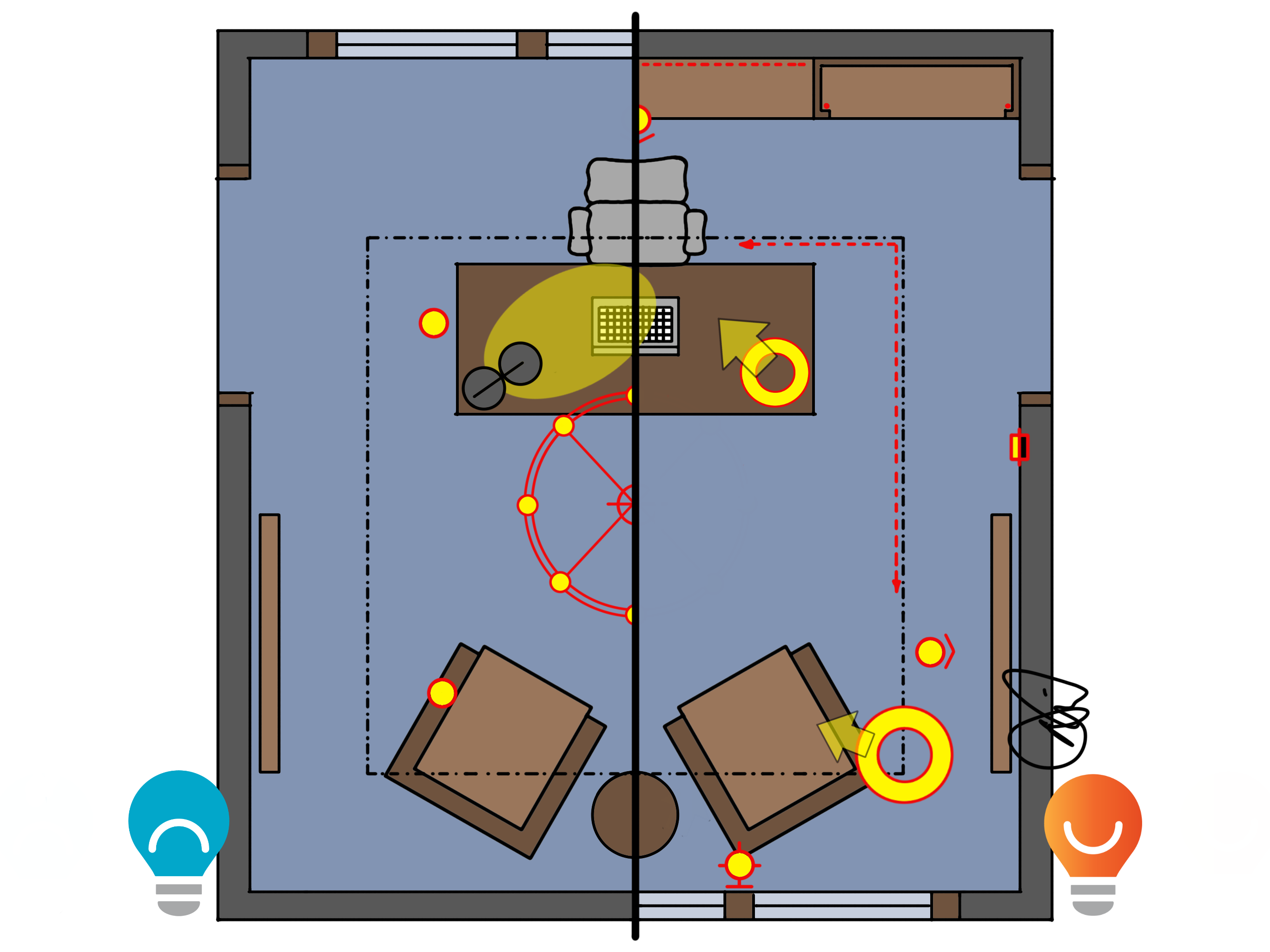Most of my blog posts are written at the sit/stand desk in my office from home, a desk that also serves as my main place of work, day after day. Our company began moving towards remote work before the pandemic and never looked back, which means home offices and their lighting are pretty important to us.
We are not alone. A growing number of people work from home some of the time, and I suspect home offices will be a part of our built environment for a good while. I have seen house designs come through with isolated workspaces for each member of the family, including the children, and hotels designed with desks that do not have a bed in the background for video conferences.
I feel fortunate to work from home and to have a dedicated room to do so. It is by no means large but is private (more so I do not annoy my family than the other way around, surprisingly) and fully functional. I know many others who are making do with a corner of a living room or bedroom, and I can imagine the desire to work from home is lower when the desk is in the middle of daily life. But no matter where your desk sits in the home, light can make a difference.
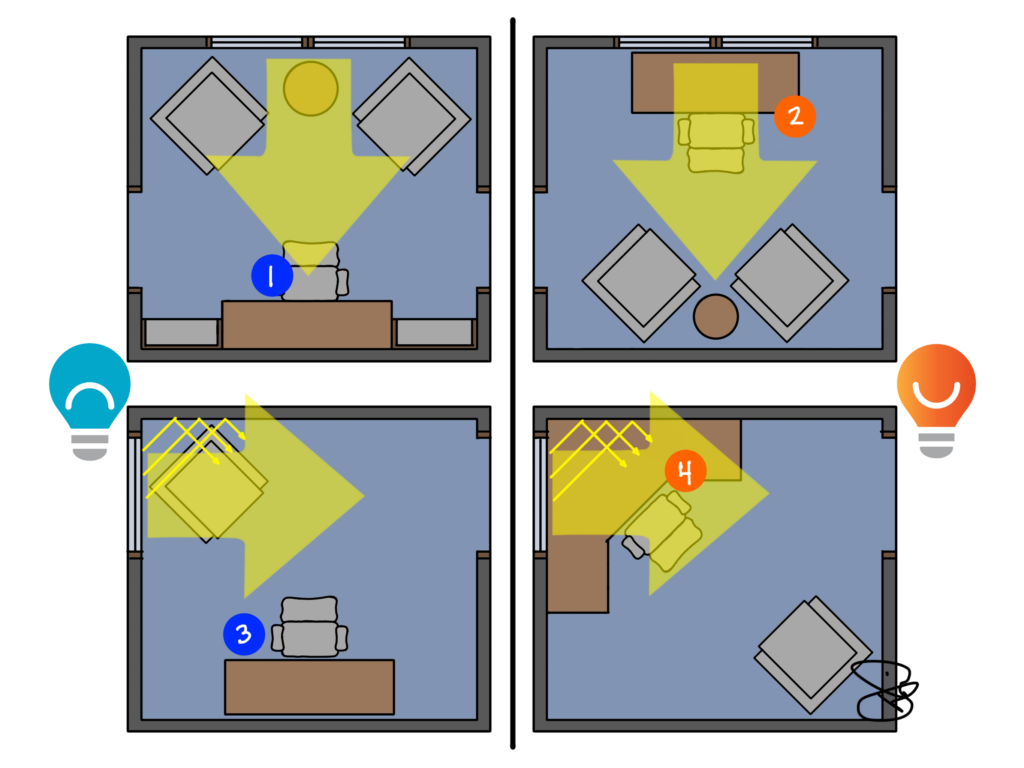
When our family moved to Madison, Wisconsin, in the summer of 2019, I set up a room in the basement as my temporary office. COVID happened and I stayed in that temporary space for three years before I got sick enough of being a cave dweller and commandeered a room with windows. Natural light is the best light, and working without it is not good for the body, mind, or soul.
Where we put the natural light- or where we put the desk in relation to windows- is the first thing to consider when setting up and lighting a home office. For a number of reasons, humans do better when natural light and views beyond the room are readily available. That gets us into our first list of Don’t/Do This ideas for the home office.
- Don’t put your desk facing a blank wall with a window behind you. I know this will not always be possible (and there are always exceptions to these rules), but whenever possible avoid putting your desk in what will likely be the darkest part of the room. The bright window will also cause trouble when videoconferencing, and you will miss out on whatever nature or sky you can see.
- Do put the desk facing a window. Your body needs a lot more light in the morning than most of our homes provide, so maximize it by facing your desk towards natural light. Depending on the room’s orientation, you may need blinds, shades, or privacy curtains, but keep them as open as possible when you can. A window with blinds closed is not much better than a blank wall.
- Don’t put your desk facing a blank wall with windows behind and to the side. This may be a little better on Zoom than the previous example, but the strong backlight will still cause video problems and you will miss out on much-needed natural light.
- Do put your desk in the corner if the window lives there, too. A corner desk as shown here effectively puts the window in front of you, and light will bounce off the wall and softly illuminate your desk and face.
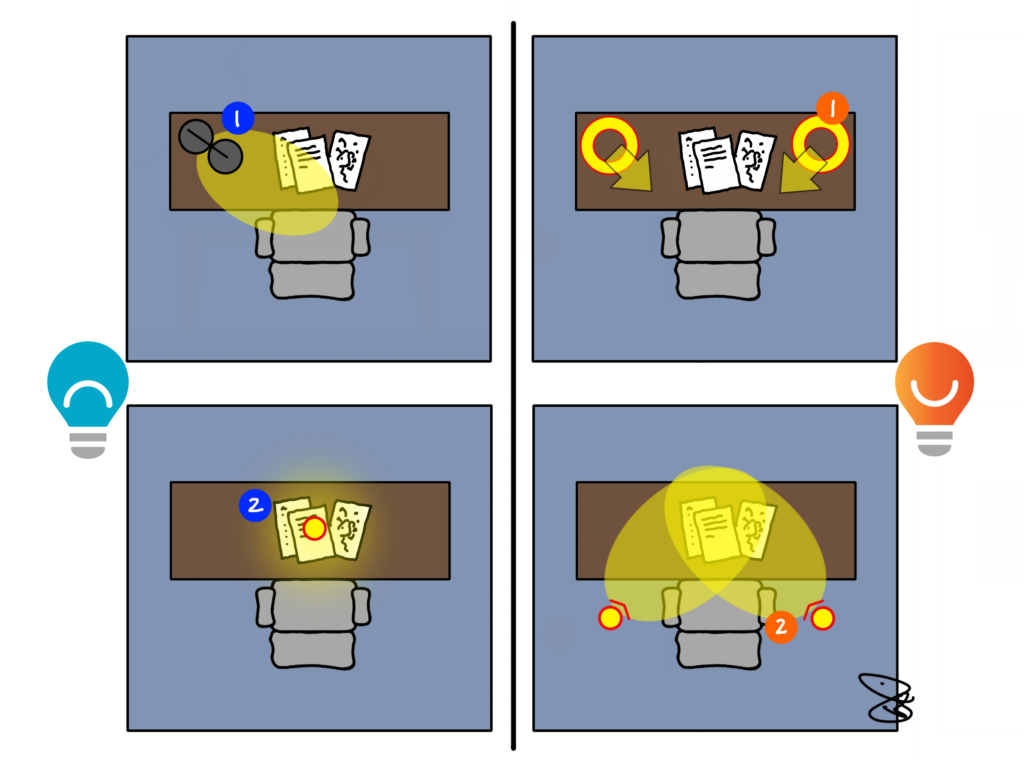
Most of us associate offices with work, and I spend most of my time in the office working on a computer, tablet, or paper. I still do some hand sketching and quite a bit of old-school notetaking with pencil, and that means I need decent light on my desk. Let’s look at a few Don’t/Do This strategies for desk work.
- Desk lamps that direct light downwards onto the surface of the desk are pretty common, and there is a sleek modern version sitting next to me in the hotel where I am writing this post. These will put light on the desk, and those with solid metal shades will minimize glare, but one-sided lighting can cast harsh shadows just where you need them the least. A better strategy is to use a pair of table lamps on both sides of the desk, which provide softer light that fills in shadows.
- Lighting from directly above, like a recessed downlight, adds strong, bright light in what I like to call the “glare zone.” Sure, it will light the desk. But it will also cause glare where our eyes are most sensitive to it, and you will likely get eyestrain and fatigue as a result. Whenever possible, use adjustable recessed lights just behind your head (out of eyesight) and over each shoulder to cancel out shadows.
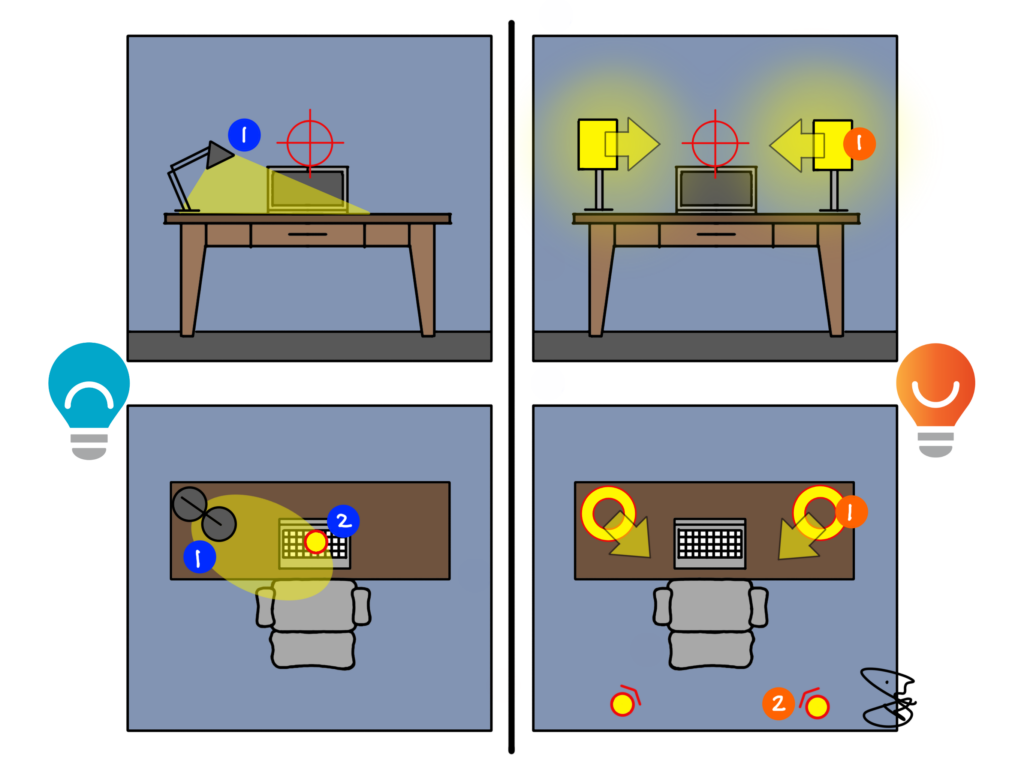
I also spend a lot of time in video conferences with my team, clients, and industry partners. In fact, some days I spend up to seven hours on Zoom, sitting and standing for variety, and that means my virtual guests collectively spend a lot of time looking at my face. It’s not the prettiest of faces, so treating it with a little soft light can make it easier on my guests (and make me feel a little less self-conscious, though that is rather rare).
- Don’t use desk lamps for virtual meetings, as the light will hit the desk, bounce up, and make you look a little creepy. The people on the other end of the video conference will have difficulty seeing your face, and this has psychological results that won’t help your case unless you are intentionally trying to frighten them. Instead, a pair of table lamps on each side of your camera (but behind/out of view of the camera) can cast soft, even light on your face. If you want to look good on camera, you need this kind of light.
- The worst light for cameras and video conferencing is desk lights…paired with strong overhead lighting. This casts deep shadows on your face, highlights your wrinkles (okay, maybe MY wrinkles), and will introduce negative emotions to what most of us hope will be a positive experience. Instead, pair two table lamps with strong recessed adjustable lighting behind your head. When aimed at the back of your neck, this light will highlight your shoulders and head. It’s a Hollywood trick called “backlighting,” and it seriously makes everyone look their best. I usually don’t have mine turned on for everyday conversations, but it’s always on for important meetings.
If you get plenty of access to natural light, keep your background from getting too bright, add soft light to your desktop and face, and sneak in a backlight for highlighting, you’ll have an office that works well on and off the camera.
What about the rest of the room? The principles of good lighting apply: keep glare out of your eyes by minimizing strong light directly overhead, bounce light softly into the room by creatively illuminating walls, art, and bookcases, get strong light where your hands do the work, and add some light down low for safety at night.
For those of you who want to go all in, here’s a plan view showing a few different strategies to avoid or embrace.
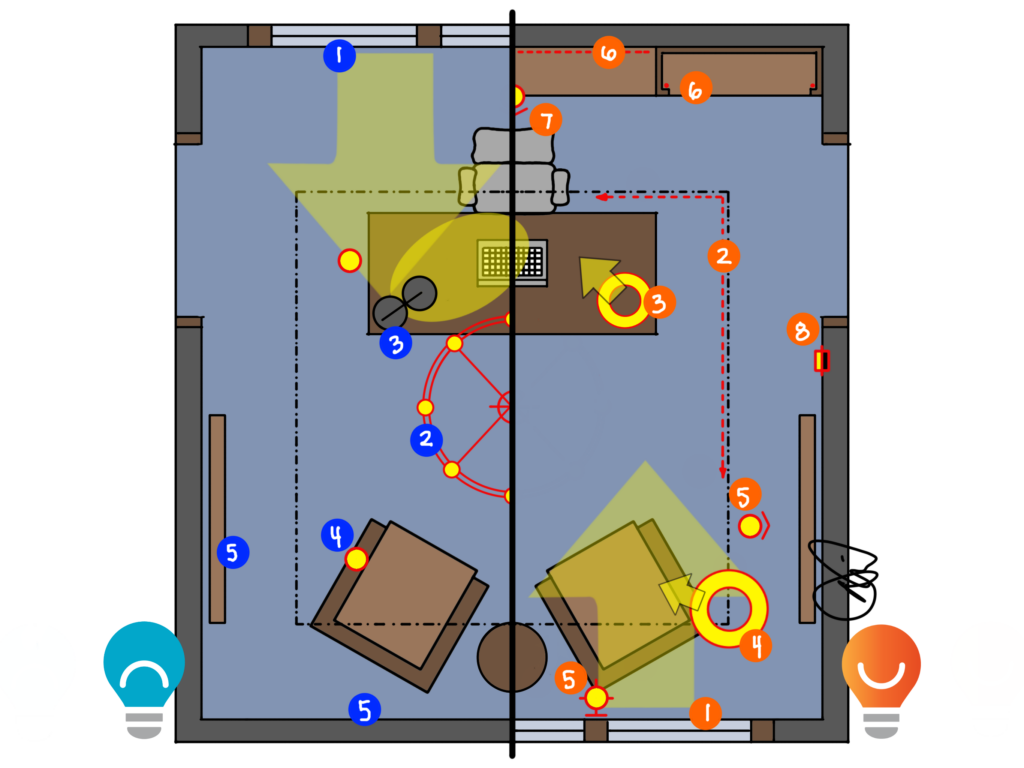
Don’t Do This in your home office:
- Put your back to the windows. You will miss out on views, lack important natural light for your wellbeing, and make yourself look dark in video conferences.
- Rely on trendy chandeliers or ceiling fixtures for useable light. They may look great in the store or online, but the light the give off usually adds more glare than comfort.
- Use task lamps that cast shadows on your desk and make your face creepy.
- Place four cans in the room where they will miss the desk, cause glare for those seated, and generally put light where it is not needed. Even worse, disk or wafer “canless recessed” lights will provide poor useable light and maximum discomfort glare.
- Don’t leave your walls dark. This is where your eyes naturally rest and where we usually put our windows. Walls and art can be great sources of indirect light when light is bounced off them.
Do This instead:
- Turn your desk to face the window to access natural light your body needs and illuminate your face for video conferencing.
- Bounce light off the ceiling gently by illuminating coves and crowns.
- Use table lamps on your desk to softly illuminate the desktop and your face for video cameras.
- Use lamps for reading light in sitting areas. Just over the shoulder is ideal.
- Add light to your walls by illuminating artwork, adding sconces…
- …grazing textures, or lighting cabinetry. Our body wants these surfaces to be bright, like a window.
- Add a backlight to look your best on camera.
- Add built-in step lights or toe-kick lighting for nighttime pathway illumination, safety, and comfort.
Whether you work at home a little or a lot, whether your desk is in the corner of the living room or in the center of a dedicated office, light can help you work, meet, and more when you use the right light in the right place at the right time.
For more of my Don’t/Do This posts, click HERE.
For more of my posts on lighting home offices, click HERE.
For more on lighting for Zoom and video conferencing, click HERE.
